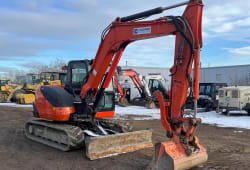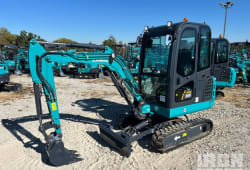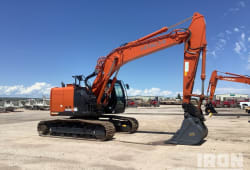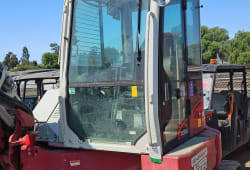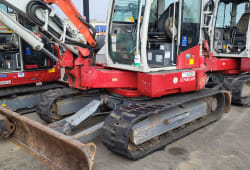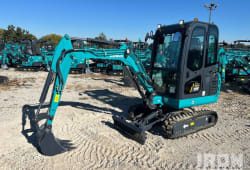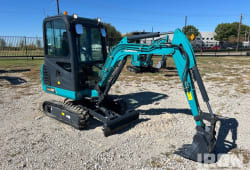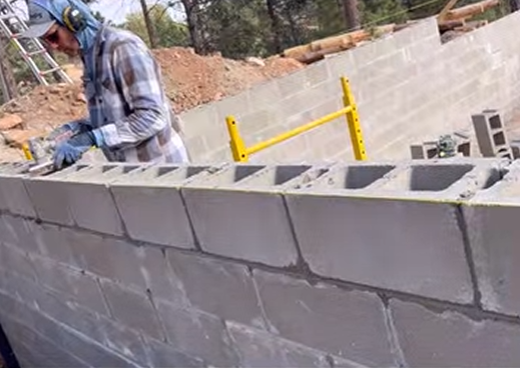The Fundamental Guide to Excavator Sizes: Ideal Equipment for Your Jobsite
9 Min read
)
May 11, 2023
The omnipresence of excavators on nearly each job website is a testament to their versatility, internet strength, weight, and indispensability inside the realm of production. Whether for digging trenches, hauling weighty substances, or grading landscapes, excavators upward push to the task, improving overall performance and productivity. The vast collection of sizes they come in is another issue contributing to their ubiquity. This manual is designed to help you comprehend the distinct excavator sizes and pick the high-quality one that suits your precise wishes, considering your assignment requirements and what each gadget can provide.
Excavator Sizes: A Comparative Overview
The size of an excavator is generally decided by its weight, which serves as a more accurate measure of its energy and digging prowess than dimensions, including peak or width. An excavator's weight can vary from as light as 2 to 3 heaps to as much as 45 lots and beyond.
Mini Excavators (Compact Excavators)
:format(webp))
Mini excavators are the smallest within the excavator family. Typically weigh 6 tons or much less. These machines are recognized for their skill, especially in tight spaces, and their purpose for minimum environmental disruption. A popular model in this class is the Caterpillar 301.5, which offers power, management, and compact-size stability. Cat mini excavators are a superb desire for a mini-ex. The Bobcat E20 is another nicely-appeared mini excavator, regarded for its 0 tail swing (ZTS) design, allowing advanced maneuverability in tight spaces. Mini excavators are typically used in landscaping, small production tasks, and utility installations.
Midi Excavators
Midi excavators, weighing between 6 to ten lots, provide a blend of strength and compactness. They can manage well-known construction duties and are small enough to operate in sensitive regions. The Volvo ECR88D is a midi compact excavator famous for its robust digging functionality and gas efficiency. Similarly, the Hitachi ZX85USB-5 is every other widespread desired cat big excavator, presenting a brief tail swing profile for flexibility in constrained spaces in conjunction with widespread digging and lifting power. Midi excavators are often applied in residential construction, road preservation, and software paintings.
Standard Excavators
Standard excavators, falling in the 10 to forty-five-ton weight magnificence, are the maximum typically seen on production sites. These versatile machines can manage various tasks and are appropriate for diverse packages. The Komatsu PC210LC-eleven is a famous, well-known excavator, supplying sturdy energy output and magnificent gasoline performance. The Caterpillar 336F is another well-preferred version in this class of cat excavators, boasting gasoline-efficient engines and superior hydraulic generation for green operation and high productivity. Standard excavators are utilized in various creation projects, which include excavation, demolition, trenching, and cloth handling.
Large Excavators
Large excavators, weighing over forty-five heaps, are designed for heavy responsibility creation obligations. These machines excel in big-scale earthmoving tasks, mining operations, and principal infrastructure improvement. The Liebherr R 9800, a cat excavator with a running weight of over 800 tons, is one of the world's biggest and most effective excavators. The Komatsu PC8000-6, acknowledged for its excessive manufacturing and low maintenance fee, is another worthy model in this CLA compact excavator class. Large excavators require significant funding and renovation; however, they offer unrivaled strength and productivity in going back. They are hired for annoying tasks, including open-pit mining, quarrying, and main earthwork construction.
When choosing an excavator size, consider the unique necessities of your task, along with the task website's dimensions, scope, and environmental constraints. Matching the excavator length to the process ensures the excavation task's most effective performance, productivity, and cost-effectiveness. At Boom & Bucket, our knowledgeable crew can assist you in identifying the right excavator size for your creation desires, considering the mission specifications and your operational requirements.
Key Considerations When Choosing an Excavator
Selecting the right excavator entails more than just sizing. Several important factors must tell your decision at the considerable excavator, together with the subsequent:
Digging Depth
Since excavators are, in most cases, designed for digging, you should not remember the depth of digging required, how regularly you will be digging holes and need to dig at that intensity, and your capability and destiny of digging desires. Understanding the maximum digging depth of an excavator is vital to ensure it can cope with your projects correctly. Factors including the type dig depth of soil and underground utilities must also be considered.
Lifting Capacity
Assess the heaviest substances on your activity websites and how regularly you want to transport them. An excavator's lifting capacity determines its capacity to lift and deliver heavy loads. Remembering the lifting abilities of tracked excavators and the lifting capacity at numerous reach distances is vital. Additionally, consider the materials you are probably lifting in the future to ensure the excavator can cope with capacity requirements.
Worksite Conditions
The size and nature of the activity completed, your task website, the terrain type, and the ability to identify obstacles or risks are all crucial considerations for selecting an excavator. If your worksite has a constrained area or requires maneuvering around boundaries, you may need an excavator with a compact layout and exceptional maneuverability. Alternatively, if you're running on hard terrain, you may require a more effective excavator with improved balance and music options suitable for such situations.
Budget
Your monetary constraints will, in large part, determine the excavator you can afford. Weigh the usage, storage, protection, and transportation fees against your budget. Consider your financing alternatives and whether renting or buying large excavators is an excellent financial experience. It's crucial to balance your budget and the excavator's abilities to ensure you get a fantastic price for your investment.
Machine Specifications
Beyond length, excavators include several features to consider. The bucket capability, for example, can affect the amount of cloth you can move to the most profound depth in line with the cycle. Choosing a bucket size that aligns with your mission necessities is critical. The reach of the device, or the distance it can dig or raise from its base, is another vital issue. Evaluate the attained capabilities to ensure they meet your precise initiatives' wishes.
The tail swing configuration can affect how the excavator operates in tight areas. Consider whether you want an excavator with a 0 tail swing, a hydraulic gadget, a reduced tail swing, or a traditional tail swing primarily based on your worksite necessities. Additionally, the styles of attachments you would want for particular obligations must be considered. Some excavators provide extra versatility with various attachment options, buckets, hydraulic structures, hammers, grapples, and drills.
We recognize that despite ample understanding about excavators, figuring out precisely what amount of cat excavator you want can take time and effort. At Boom & Bucket, we're here to assist you. With a group of professionals and flexible excavators spread across the United States of America, you can rely on us for all of your creation needs. Our informed personnel can help examine your venture necessities, provide customized recommendations, and guide you in deciding on the precise excavator that meets your needs.
Excavators: Digging into Precision and Productivity
Types of Excavators
Excavators come in diverse types, each tailored for particular tasks, from underground particle elimination to dock work. To analyze approximately the different varieties of excavators and their unique programs, reach out to one of our group members for help determining which suits your use case.
Renting vs. Buying Excavators: Making the Right Choice
The preference between renting medium excavators and shopping for an excavator must be more honest and depends on your precise instances. Both options have advantages and knowledge that allow you to make an informed decision.
Purchasing an excavator is typically more potent in the long term. While you will be responsible for the garage and renovation, the system is yours, freeing you from ongoing condominium payments. Additionally, proudly owning an excavator gives you extra control and flexibility over its use, permitting you to adapt it to your particular needs. You can personalize the system with unique attachments and configurations to optimize its performance on your projects. Buying wheel excavators is typically the better choice if you use the system often and frequently because it gives a better return on funding over the years.
Conversely, renting an excavator may be a practical solution for supplementing or maximizing your fleet. Renting allows you to get the right of entry to various excavator fashions and sizes, giving you the power to select the most appropriate one for every task. It removes the need for long-term financial dedication and the responsibility of garage and maintenance. Renting can also be better if the machine is used seasonally or sporadically, as you most effectively pay for the gadget while wanted. This may be specifically useful for small-scale excavation initiatives or while your budget does not allow for significant upfront funding.
When finding out between renting and shopping, it's essential to consider the assignment length of heavy equipment used, frequency of use, price range, and lengthy-term commercial enterprise dreams. Conduct an intensive analysis of your needs and examine the charges and advantages of every option. Consider the monetary implications, initial funding, ongoing upkeep charges, running costs, storage expenses, and the ability to resell the price of the excavator if you decide to sell it inside the Destiny.
Putting It All Together
In conclusion, deciding on the right excavator length and sort is crucial to any construction task. Knowing the specific sizes, types, and issues, you could select an excavator that fits your mission's needs and budget. Whether you lease or purchase a great excavator, weigh the blessings and drawbacks primarily based on your specific requirements and make a selection that aligns with your lengthy-time period desires. If you want assistance figuring out the most appropriate choice for your production wishes, the professionals at Boom & Bucket are prepared to provide steerage and guide the selection-making procedure.
In Need of a Used Excavator or Other Heavy Equipment?
Suppose you're searching for a used mini excavator or other heavy system for your next task. You have got to come to the proper location. Here at Boom and Bucket, our challenge is to be the most trusted virtual provider for all things heavy systems. We earn that agreement through transparency and equity and ensure that it is subsidized with the aid of global elegance technology and splendid customer support. Follow us at @boomandbucket or contact us at boomandbucket.com.

Rex Walz is Boom & Bucket's Manager of Supplier Relations, bringing over a decade of experience in B2B sales and heavy equipment solutions. With a background spanning government, construction, industrial, and commercial sectors, he has a proven track record of driving growth and building trusted customer relationships. At Boom & Bucket, Rex is passionate about helping partners succeed while advancing the company's mission to create the most trusted marketplace for heavy equipment.
